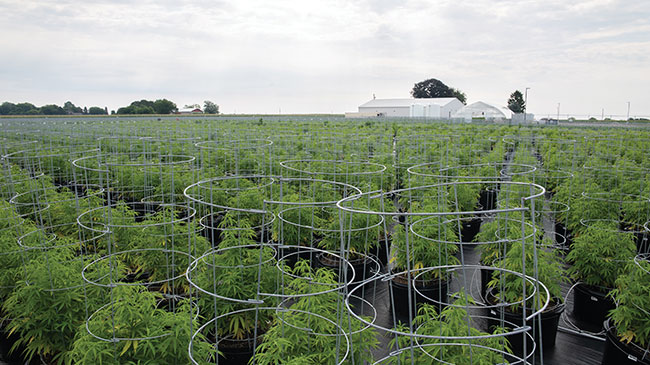
Features
Cultivation
Production
Vantage Point: Beyond sun and soil
September 3, 2021 By Michael Budinsky
 Photo: Mariwell
Photo: Mariwell To grow outdoors or not to grow outdoors? That is a question that’s frequently asked by licensed producers and consumers, often leading to in-depth discussions amongst industry experts about the perceived pros and cons of each. Outdoor growing presents many different opportunities compared to indoor growing – ones that simply go beyond sun, soil and savings.
Harnessing Mother Nature
Utilizing Mother Nature is a well-known benefit of outdoor growing to produce the best possible harvest. Cannabis loves sunlight, so choosing a location that provides a good amount of natural light from the right direction is critical. Location is often the first decision producers make when choosing the great outdoors as a dependable environment for their crops and the local community.
Sustainable growing
The benefits of sustainable growing practices not only extend to the plants, but to the farm, community and beyond. Growers have quickly realized that it’s not the size of their operation that determines how sustainable or eco-friendly they are, rather it’s their commitment to ensuring the best for the plant and environment.
Licensed producers, like Mariwell in Wheatley, Ont., are making a greater push for sustainability through a considered approach to always grow in natural soil without the use of any synthetic fertilizers and pesticides. This approach also looks to introduce ‘companion planting’ as a natural way to protect precious cannabis crops.
Companion plants effective in protecting plants from and build resistance against pest invasions and some diseases, while promoting a natural ecosystem.
“These ally species attract beneficial insects to the garden that can clear up detrimental species, in no time. Companion plants can also provide additional nutrients, increase yield, and enhance the flavour and health of plants,” says Theresa Robert, chair of the board at Mariwell.
Companion planting has also been shown to result in better water penetration, as well as increased water absorption and natural soil nutrients. Investing in permaculture techniques is an important part of outdoor growing. Experienced growers understand that things take time and are ready to invest the care involved with utilizing and managing biological materials for better results and long-term success.
Going natural
Natural materials, like compost, are a simple, cost-effective, and nutrient-packed way to fertilize cannabis plants.
For example, Mariwell has built a strong relationship with a nearby vegetable greenhouse, in which we give them a place to bring their organic vegetable waste, adding it to our compost and herb garden. All organic waste is mixed with topsoil for compost to be used the following year.
By providing the sought-after nutrients plants are hungry for, compost is also a cost-effective way to activate the soil. Waste control is made easier with compost as it allows licensed producers to easily add waste efficiency to their operational processes and improve plant growth patterns. To truly reap the benefits of outdoor growing, soil and water quality need to be maintained.
Agricultural water solutions
Water management and conservation are a crucial part of growing outdoors. To reduce potential detrimental effects to the environment, licensed producers have opted for fertigation and irrigation systems to minimize impact often associated with large-scale cultivation operations.
The good news is in the last few years, innovative agricultural techniques such as automated systems have helped to dramatically reduce usage and increase productivity by effectively measuring water and nutrient content in the soil.
“When possible, we rely on Mother Nature’s watering device,” says Brendon Ditmar, master grower at Mariwell. “At Mariwell, we have an automated system that can target different areas on the field. This allows us to consistently monitor nutrients and moisture levels in the soil that minimize water usage, and provide valuable information to ensure we meet plant needs while minimizing our footprint.”
Improvements with each harvest season
Outdoor cultivation affords farmers the ability to continually improve techniques, practices, strains and yields with each season past. With regulations and the industry evolving, coveted outdoor spaces will continue to be the optimal home for harmonizing the environment with cultivation to grow quality cannabis.
So, when asking whether or not to grow outdoors, the ultimate deciding factor will always be the goal(s). With advantages to both, mimicking the natural elements can still pose a challenge for indoor growers, sometimes one greater than working with prevailing environmental factors.
In the end, high potency, quality cannabis will always be found where efficient agricultural practices find synergy with Mother Nature.
Michael Budinsky is the marketing and security manager at Mariwell. His particular area of focus is training cannabis plants and controlling their structure through different growing techniques.
Print this page